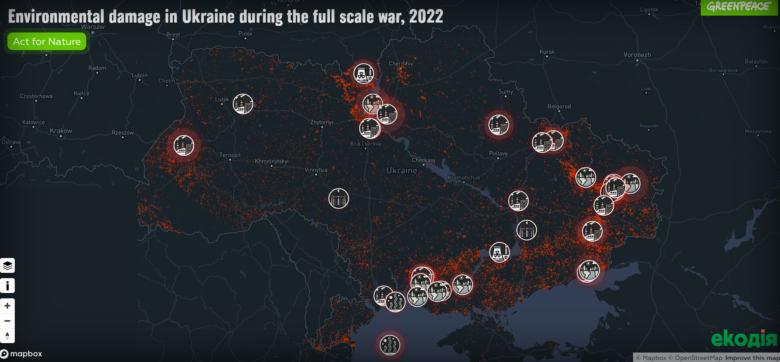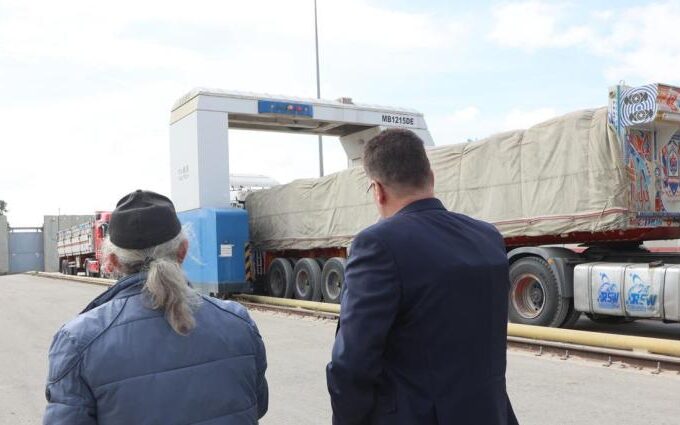Greenpeace Central and Eastern Europe (Greenpeace CEE), in collaboration with the Ukrainian NGO Ecoaction, today published an “Environmental Damage Map” illustrating the various environmental damage caused by the war that Russia is waging in Ukraine.
These damages, which come on top of the terrible human tragedy of this war which Greenpeace continues to condemn, should be taken into account by the Ukrainian government and by the European Commission’s donor coordination platform, in order to plan and finance the future environmental restoration work in Ukraine.
Information on this damage was collected in the field by Ecoaction, then cross-checked with satellite images and mapped by Greenpeace. Of nearly 900 cases identified, 30 of the most serious are shown on this map; they are classified by type of damage and are accompanied by a brief description. Since the war is not over, Ukrainian experts continue their monitoring work.
“Mapping the damage caused by the war in Ukraine is complicated: much of the liberated territory is undoubtedly riddled with mines and other explosives, while Russian forces still occupy certain areas of the country, which makes it difficult to collecting data in these areas, says Denys Tsutsaiev, Greenpeace CEE campaigner from Kyiv. However, we must draw attention to the environmental damage of this war so that environmental restoration is also taken into account in the discussions on the future of Ukraine. This work will require tools, expertise and commitment, as well as significant funds. These funds should be allocated now, not after the war is over.”
According to Official Information
According to official information, since February 24, 2022, 1.24 million hectares of nature reserve have been affected by the war on Ukrainian territory. Three million hectares of forest have also been affected, of which 450,000 are under occupation or in combat zones.
“War affects nature, not just people and infrastructure. However, this damage remains invisible and most often ignored, as the environment is a silent victim. We want to be its voice so that everyone is aware of the damage inflicted on the environment by the Russian war, and that the restoration of nature is an integral part of the reconstruction plans, explains Yevheniia Zasiadko, of the NGO Ecoaction. After the end of the war, we will suffer for a long time from its repercussions on the environment. The Ukrainian government promises to rebuild our homeland – and the environment is part of what needs to be rebuilt.”
The map illustrates how the Russian invasion is destroying Ukrainian nature: land and habitats are damaged, missile strikes cause forest fires, soil and water are polluted. The fires of industrial sites caused by the bombardments also lead to air, soil and water pollution.
In addition, rocket and artillery explosions disseminate a cocktail of chemical compounds: carbon monoxide and dioxide, water vapour, nitric oxide (NO), nitrogen oxide (NO2), nitrous oxide (N2O) , formaldehyde, hydrogen cyanide vapor (HCN), nitrogen (N2). After explosion, these compounds are fully oxidized and the reaction products are released into the atmosphere. The main ones (carbon dioxide and water vapour) are not toxic but contribute to climate change. Sulfur and nitrogen oxides can also be the source of acid rain, modifying the pH of soils and causing burning of vegetation, especially conifers. Acid rain is also dangerous for humans, other mammals and birds, as it affects the mucous membranes and respiratory organs.
The metal fragments of the shells are also dangerous for the environment. The alloy of cast iron and steel, the material most frequently used for ammunition casings, contains not only the usual iron and carbon, but also sulfur and copper. These substances end up in the soil and can seep into groundwater and even contaminate human and animal food chains. This environmental damage has been ongoing since 2014, when Russian troops first set foot on Ukrainian soil. Since then, parts of the country have been occupied by Russia. Thanks to international monitoring, we know that more than 30 coal mines have been flooded since 2014, and after the start of the large-scale invasion, another 10 were flooded in June 2022. The Donbass region poses significant risks environmental disaster with impacts on the health of the surrounding population.
Greenpeace CEE and Ecoaction believe that the reconstruction of cities in Ukraine must go hand in hand with the restoration of the environment. The suffering and destruction of nature in times of war is immense and will have long-term consequences on the lives of all inhabitants and ecosystems in the affected areas. That is why environmental organizations call for the establishment of mechanisms and the allocation of financial resources for the restoration of the environment in Ukraine.
Greenpeace encourages support for Ukrainian NGOs working to restore the environment and monitor impacts on the ground.
Greenpeace also continues to monitor and warn of serious nuclear risks around the Zaporizhzhia power plant.
This article is originally published on greenpeace.fr








